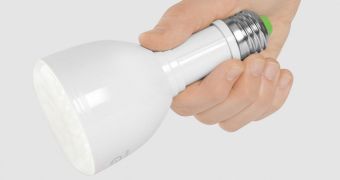Light-emitting diodes are highly efficient means of producing light, superior to regular light bulbs and halogen lights. Unfortunately, the higher cost of manufacture has held them back from taking over the market. Until now.
A breakthrough in transistor research and development has finally made it possible to manufacture LED light bulbs at a price close to that of incandescent ones.
And with old-fashioned incandescent light bulbs banned in the EU, with halogen lights likely to suffer a similar fate, LED really need to get their act together.
Well, close enough, at least, for widespread availability in large-scale commercial applications at any rate.
LEDs already win, hands down, in terms of low energy consumption and long lifespan, but they are rather sensitive to current fluctuations.
Normally, they use a DC power supply or driver to compensate for that sensitivity, but that relies on a high-speed, high-frequency switching transistor that isn't exactly cheap to make.
Thus, the affordability of LED lights rests on the price of that transistor and, now, The Fraunhofer Institute for Applied Solid State Physics in Freiburg claims to have overcome the problem.
The scientists there have found a way to develop a new, cheaper high-performance transistor, one made of gallium nitride.
Compared to silicon transistors, its efficiency is better by 86%. What's more, in addition to cost reduction, the efficiency will be further improved, and size has been reduced as well.
All in all, compared to silicon transistors, the researchers say, they are 10 times faster. Ergo, they switch at frequencies ten times as high as silicon equivalents.
Basically, the team, led by Dr. Michael Kunzer, group manager at Fraunhofer IAF, has created a way to make cheaper, smaller and longer-lasting LED lamps.
Considering that making them cheaper was the only thing standing in the way of mass adoption of LED lighting, having improvements in the other two areas is a great boon. For those who want numbers, a LED should last for 15,000 to 30,000 hours, versus incandescent bulbs' 1,000 and fluorescent ones' 8,000.
Add to that the lack of harmful substances (like mercury) and LED tech really is as green as it can get. No wonder that researchers believe they will account for half of the global market five years from now, in 2019. Finally, since LED bulbs for use in standard, domestic fittings are already up for sale, they should exceed traditional energy-saving bulbs by 2015.

 14 DAY TRIAL //
14 DAY TRIAL //